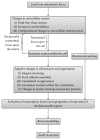Periodontal Biological Events Associated with Orthodontic Tooth Movement: The Biomechanics of the Cytoskeleton and the Extracellular Matrix
- PMID: 26351659
- PMCID: PMC4550806
- DOI: 10.1155/2015/894123
Periodontal Biological Events Associated with Orthodontic Tooth Movement: The Biomechanics of the Cytoskeleton and the Extracellular Matrix
Abstract
The mechanical stimuli generated by orthodontic forces cause deformation of extracellular matrices and cells, vascular changes, inflammation, and the release of active biological agents generating a complex multifactorial sequence of biological events culminating in bone remodelling enabling orthodontic tooth movement. Orthodontic forces on the teeth generate stresses in periodontal tissues according to a number of variables including the type (continuous, interrupted, or intermittent), magnitude, direction, and frequency of the applied load. Whether the strain is compressive or tensile determines whether bone deposition or bone resorption will occur. The mechanically induced strains mediate structural changes in extracellular matrices and in cells, consequently affecting cellular gene expression and function. In the extracellular matrix, mechanosensing molecules integrated into the structure of various proteins can be activated upon load-induced protein unfolding. These specialized molecules have the capacity to sense and then to convert microenvironmental biomechanical stimuli into intracellular biochemical signals that interact to generate a coordinated tissue response. It is also possible that the applied force may directly cause nuclear deformation with configurational changes in chromatin, thus influencing gene expression. In this review article we summarize the current general concepts of mechanotransduction influencing the remodelling of periodontal tissues thus enabling tooth movement in response to applied orthodontic loads.
Figures



Similar articles
-
Biological Events in Periodontal Ligament and Alveolar Bone Associated with Application of Orthodontic Forces.ScientificWorldJournal. 2015;2015:876509. doi: 10.1155/2015/876509. Epub 2015 Sep 2. ScientificWorldJournal. 2015. PMID: 26421314 Free PMC article. Review.
-
Current concepts in the biology of orthodontic tooth movement.Am J Orthod Dentofacial Orthop. 2006 Apr;129(4):458-68. doi: 10.1016/j.ajodo.2005.12.013. Am J Orthod Dentofacial Orthop. 2006. PMID: 16627170 Review.
-
Orthodontic tooth movement: The biology and clinical implications.Kaohsiung J Med Sci. 2018 Apr;34(4):207-214. doi: 10.1016/j.kjms.2018.01.007. Epub 2018 Feb 3. Kaohsiung J Med Sci. 2018. PMID: 29655409 Free PMC article. Review.
-
Mechanobiology of the tooth movement during the orthodontic treatment: a literature review.Minerva Stomatol. 2016 Oct;65(5):299-327. Minerva Stomatol. 2016. PMID: 27580655 Review.
-
The tissue, cellular, and molecular regulation of orthodontic tooth movement: 100 years after Carl Sandstedt.Eur J Orthod. 2006 Jun;28(3):221-40. doi: 10.1093/ejo/cjl001. Epub 2006 May 10. Eur J Orthod. 2006. PMID: 16687469
Cited by
-
Stress Analysis of Periodontal Tissue in en Masse Retraction With Integration of Maxillary Anterior Teeth: A Three-Dimensional Finite Element Method Study.Cureus. 2024 Aug 31;16(8):e68277. doi: 10.7759/cureus.68277. eCollection 2024 Aug. Cureus. 2024. PMID: 39350814 Free PMC article.
-
Improvement in post-orthodontic chronic musculoskeletal pain after local anesthetic injections in the trigeminal area: a case series.J Int Med Res. 2023 Nov;51(11):3000605231214064. doi: 10.1177/03000605231214064. J Int Med Res. 2023. PMID: 38017361 Free PMC article.
-
Potential Use of Hyperbaric Oxygen Therapy in Orthodontic Treatment: A Systematic Review of Animal Studies.Eur J Dent. 2023 Feb;17(1):16-23. doi: 10.1055/s-0042-1755625. Epub 2022 Oct 11. Eur J Dent. 2023. PMID: 36220124 Free PMC article.
-
The Contribution of the Nrf2/ARE System to Mechanotransduction in Musculoskeletal and Periodontal Tissues.Int J Mol Sci. 2023 Apr 23;24(9):7722. doi: 10.3390/ijms24097722. Int J Mol Sci. 2023. PMID: 37175428 Free PMC article. Review.
-
Biomechanical cell regulatory networks as complex adaptive systems in relation to cancer.Cancer Cell Int. 2017 Feb 1;17:16. doi: 10.1186/s12935-017-0385-y. eCollection 2017. Cancer Cell Int. 2017. PMID: 28167863 Free PMC article. Review.
References
-
- Cattaneo P. M., Dalstra M., Melsen B. Moment-to-force ratio, center of rotation, and force level: a finite element study predicting their interdependency for simulated orthodontic loading regimens. American Journal of Orthodontics and Dentofacial Orthopedics. 2008;133(5):681–689. doi: 10.1016/j.ajodo.2006.05.038. - DOI - PubMed
Publication types
MeSH terms
Substances
LinkOut - more resources
Full Text Sources
Other Literature Sources

